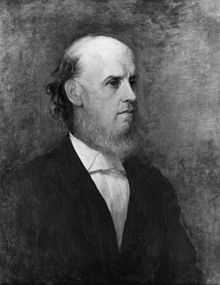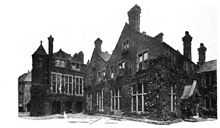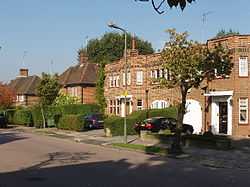Samuel Barnett (reformer)
| Samuel Augustus Barnett | |
|---|---|
 Samuel Augustus Barnett by George Frederic Watts | |
| Born |
8 February 1844 Bristol, England |
| Died | 17 June 1913 (aged 69) |
| Venerated in | Church of England |
| Feast | 17 June |
Samuel Augustus Barnett (8 February 1844 – 17 June 1913[1]) was an Anglican cleric and social reformer who was particularly associated with the establishment of the first university settlement, Toynbee Hall, in east London in 1884.
Early life
He was born in Bristol, the son of Francis Augustus Barnett, an iron manufacturer. After leaving Wadham College, Oxford, in 1866, he visited the United States. In the following year he was ordained as a deacon and became the curate of St Mary's, Bryanston Square before being ordained as a priest in 1868.
In 1873, he married Henrietta Octavia Weston Rowland (1851–1936), heiress, social reformer and author,[2] who had been a co-worker of Octavia Hill. Both were social reformers and philanthropists with broad cultural interests. Later that year, the Barnetts moved to the impoverished Whitechapel parish of St. Jude’s intent on improving social conditions in one of London's worst slums.
Social reform
The East End area was notorious for its squalor and overcrowded housing conditions, as well as prostitution and other criminal activities. The Barnetts worked hard for the poor of their parish—opening evening schools for adults, providing them with music and entertainment, and serving on the local board of guardians and on the managing committees of schools. Barnett discouraged outdoor relief, because it fostered the pauperisation of the neighbourhood. At the same time, the Barnetts helped improve conditions of indoor relief, and co-ordinate the various charities by co-operation with the Charity Organization Society and the parish board of guardians.

In 1875 Balliol historian Arnold Toynbee paid the first of many visits to Whitechapel. In 1877, Barnett, who kept in constant touch with Oxford, formed a small committee, over which he presided, to consider the organisation of university extension in London. His chief assistants were Leonard Montefiore, a young Oxford man, and Frederick Rogers, a member of the vellum binders' trade union.
The committee received influential support, and in October four courses of lectures, one by Dr. Samuel Rawson Gardiner on English history, were given in Whitechapel. The Barnetts were also associated with the foundation of the East End Dwellings Company, which built many model dwellings in the East End from 1888, with the establishment of the Children's Country Holiday Fund (1884) and the annual loan exhibitions of fine art at the Whitechapel gallery.
University settlements
In 1884 an article by Barnett in Nineteenth Century discussed the question of university settlements - places where richer students could live alongside, learn about and contribute to the welfare of much poorer people - in Barnett’s words: 'to learn as much as to teach; to receive as much to give'.
This resulted in the formation of the University Settlements Association. Toynbee Hall, named for the recently deceased historian was built shortly afterwards, and Barnett became its first Warden. In 1888 American reformer Jane Addams visited the settlement, and was inspired to create similar facilities in the United States—the first Hull House opening in Chicago a year later.
Barnett was a select preacher at Oxford in 1895-1897, and at Cambridge in 1900. In 1893 he received a canonry in Bristol Cathedral, but retained his wardenship of Toynbee Hall, while relinquishing the living of St. Jude's. In June 1906 he was given a canonry at Westminster, and when in December he resigned the wardenship of Toynbee Hall the position of president was created so that he might retain his home there.
Hampstead Garden Suburb

The Barnetts also became known for their involvement in the Hampstead Garden Suburb. This arose after the activist couple acquired a weekend home at Spaniard's End in the Hampstead area of north-west London. The Barnetts worked to protect part of nearby Hampstead Heath from development by Eton College, as well as beginning in 1904 established trusts which bought 243 acres of land along the newly opened Northern line extension to Golders Green. Henrietta broke ground for the development on her 56th birthday, and while it never was completed to the plan of architects Raymond Unwin and Sir Edwin Lutyens, it achieved worldwide acclaim.
Legacy
Samuel Barnett died in 1913 and is buried with his wife in the churchyard at St Helen's Church, Hangleton, East Sussex.[3] As a memorial, his friend Sir Alfred Yarrow dedicated a charitable building in Hampstead Garden Suburb in his name in 1916: the Barnett Homestead. A Greater London Council blue plaque unveiled in 1983 on Heath End House on Spaniards Road, Hampstead commemorates Barnett and his wife.[4] In 1914, Henrietta Barnett founded Barnett House at Oxford in his memory, and it became the Department of Social Policy and Intervention, University of Oxford.
The Barnetts jointly wrote Practicable Socialism (1888, 2nd ed. 1894), and are jointly remembered on 17 June on the liturgical calendar of the Church of England.
There is now a Toynbee Road and Samuel Barnett Close in Filwood Park, Bristol
Published work
- Barnett, Samuel Augustus; Henrietta Barnett (1972) [1888]. Practicable Socialism: Essays on Social Reform. Freeport, N.Y.: Books for Libraries Press.
- Barnett, Samuel Augustus; Henrietta Barnett (1909). Towards Social Reform. New York: Macmillan Co.
Notes
- ↑ Who's Who 1914, p. xxi
- ↑ NPG 5437; Dame Henrietta Octavia Weston Barnett at www.npg.org.uk
- ↑ Dale, Antony (1989). Brighton Churches. London EC4. p. 227. ISBN 0-415-00863-8.
- ↑ "BARNETT, DAME HENRIETTA (1851-1936) & BARNETT, SAMUEL (1844-1913)". English Heritage. Retrieved 2012-10-19.
References
-
 Chisholm, Hugh, ed. (1911). "Barnett, Samuel Augustus". Encyclopædia Britannica (11th ed.). Cambridge University Press.
Chisholm, Hugh, ed. (1911). "Barnett, Samuel Augustus". Encyclopædia Britannica (11th ed.). Cambridge University Press. - Barnett, Henrietta Rowland (1919). Canon Barnett: His Life, Work, and Friends (PDF). Houghton Mifflin. Retrieved 2008-03-31.
|